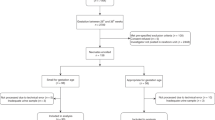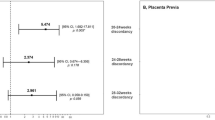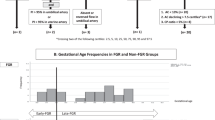Abstract
Objective:
To compare serum N-terminal pro-brain natriuretic peptide levels at birth between monochorionic diamniotic twins with and without selective intrauterine growth restriction.
Study Design:
Blood samples were collected from 73 monochorionic diamniotic twins without twin-to-twin transfusion syndrome. Two groups were studied on the basis of fetal ultrasonographic findings: 16 twins with and 57 twins without selective intrauterine growth restriction. Selective intrauterine growth restriction was defined as an estimated fetal weight below the 10th percentile in one twin at 18 to 26 weeks of gestation. Serum N-terminal pro-brain natriuretic peptide levels were measured.
Result:
Serum N-terminal pro-brain natriuretic peptide levels in monochorionic diamniotic twins with selective intrauterine growth restriction were significantly higher than in those without selective intrauterine growth restriction. Selective intrauterine growth restriction was independently associated with increased N-terminal pro-brain natriuretic peptide levels.
Conclusion:
N-terminal pro-brain natriuretic peptide levels at birth are elevated in monochorionic diamniotic twins with selective intrauterine growth restriction.
This is a preview of subscription content, access via your institution
Access options
Subscribe to this journal
Receive 12 print issues and online access
$259.00 per year
only $21.58 per issue
Buy this article
- Purchase on Springer Link
- Instant access to full article PDF
Prices may be subject to local taxes which are calculated during checkout


Similar content being viewed by others
References
Gratacos E, Lewi L, Munoz B, Acosta-Rojas R, Hernandez-Andrade E, Martinez JM et al. A classification system for selective intrauterine growth restriction in monochorionic pregnancies according to umbilical artery Doppler flow in the smaller twin. Ultrasound Obstet Gynecol 2007; 30 (1): 28–34.
Lopriore E, Slaghekke F, Vandenbussche FP, Middeldorp JM, Walther FJ, Oepkes D . Cerebral injury in monochorionic twins with selective intrauterine growth restriction and/or birthweight discordance. Am J Obstet Gynecol 2008; 199 (6): 628.e1–628.e5.
Ishii K, Murakoshi T, Sago H . Adverse outcome in monochorionic twins with selective intrauterine fetal growth restriction in the presence of abnormal umbilical artery Doppler and severe oligohydramnios. J Obstet Gynaecol Res 2012; 38 (10): 1271.
de Haseth SB, Haak MC, Roest AA, Rijlaarsdam ME, Oepkes D, Lopriore E . Right ventricular outflow tract obstruction in monochorionic twins with selective intrauterine growth restriction. Case Rep Pediatr 2012; 2012: 426825.
Kondo Y, Hidaka N, Yumoto Y, Fukushima K, Tsukimori K, Wake N . Cardiac hypertrophy of one fetus and selective growth restriction of the other fetus in a monochorionic twin pregnancy. J Obstet Gynaecol Res 2010; 36 (2): 401–404.
Munoz-Abellana B, Hernandez-Andrade E, Figueroa-Diesel H, Ferrer Q, Acosta-Rojas R, Cabero L et al. Hypertrophic cardiomyopathy-like changes in monochorionic twin pregnancies with selective intrauterine growth restriction and intermittent absent/reversed end-diastolic flow in the umbilical artery. Ultrasound Obstet Gynecol 2007; 30 (7): 977–982.
Vanderheyden M, Bartunek, Claeys G, Manoharan G, Beckers JF, Ide L . Head to head comparison of N-terminal pro-B-type natriuretic peptide and B-type natriuretic peptide in patients with/without left ventricular systolic dysfunction. Clin Biochem 2006; 39 (6): 640–645.
Walther T, Stepan H, Faber R . Dual natriuretic peptide response to volume load in the fetal circulation. Cardiovasc Res 2001; 49 (4): 817–819.
Johns MC, Stephenson C . Amino-terminal pro-B-type natriuretic peptide testing in neonatal and pediatric patients. Am J Cardiol 2008; 101 (3A): 76–81.
Moriichi A, Cho K, Mizushima M, Furuse Y, Akimoto T, Yamada T et al. B-type natriuretic peptide levels at birth predict cardiac dysfunction in neonates. Pediatr Int 2012; 54 (1): 89–93.
Bajoria R, Ward S, Sooranna SR . Atrial natriuretic peptide mediated polyuria: pathogenesis of polyhydramnios in the recipient twin of twin-twin transfusion syndrome. Placenta 2001; 22 (8–9): 716–724.
Van Mieghem T, Done E, Gucciardo L, Klaritsch P, Allegaert K, Van Bree R et al. Amniotic fluid markers of fetal cardiac dysfunction in twin-to-twin transfusion syndrome. Am J Obstet Gynecol 2010; 202 (1): 48.e1–48.e7.
Habli M, Cnota J, Michelfelder E, Salisbury S, Schnell B, Polzin W et al. The relationship between amniotic fluid levels of brain-type natriuretic peptide and recipient cardiomyopathy in twin-twin transfusion syndrome. Am J Obstet Gynecol 2010; 203 (4): 404.e1–404.e7.
Fujioka K, Sakai H, Tanaka S, Iwatani S, Wada K, Mizobuchi M et al. N-terminal pro-brain natriuretic peptide levels in monochorionic diamniotic twins with twin-to-twin transfusion syndrome treated by fetoscopic laser photocoagulation. Kobe J Med Sci 2013; 59 (1): E28–E35.
Moriichi A, Cho K, Furuse Y, Akimoto T, Kaneshi Y, Yamada T et al. B-type natriuretic peptide levels are correlated with birth-weight discordance in monochorionic-diamniotic twins without twin-twin transfusion syndrome. J Perinatol 2013; 33 (3): 182–187.
Quintero RA, Morales WJ, Allen MH, Bornick PW, Johnson PK, Kruger M . Staging of twin-twin transfusion syndrome. J Perinatol 1999; 19 (8 Pt 1): 550–555.
Ersdal HL, Mduma E, Svensen E, Perlman J . Birth asphyxia: a major cause of early neonatal mortality in a Tanzanian rural hospital. Pediatrics 2012; 129 (5): e1238–e1243.
Ogawa Y, Iwamura T, Kuriya N, Nishida H, Takeuchi H, Takada M et al. Birth size standards by gestational age for Japanese neonates. Acta Neonatol Jpn 1998; 34 (3): 624–632 (In Japanese).
Bozynski ME, Hanafy FH, Hernandez RJ . Association of increased cardiothoracic ratio and intrauterine growth retardation. Am J Perinatol 1991; 8 (1): 28–30.
Edwards DK, Higgins CB, Gilpin EA . The cardiothoracic ratio in newborn infants. AJR Am J Roentgenol 1981; 136 (5): 907–913.
Bennasar M, Martinez JM, Gomez O, Figueras F, Olivella A, Puerto B et al. Intra- and interobserver repeatability of fetal cardiac examination using four-dimensional spatiotemporal image correlation in each trimester of pregnancy. Ultrasound Obstet Gynecol 2010; 35 (3): 318–323.
Bajoria R, Ward S, Chatterjee R . Natriuretic peptides in the pathogenesis of cardiac dysfunction in the recipient fetus of twin-twin transfusion syndrome. Am J Obstet Gynecol 2002; 186 (1): 121–127.
El-Khuffash A, Molloy EJ . Are B-type natriuretic peptide (BNP) and N-terminal-pro-BNP useful in neonates? Arch Dis Child Fetal Neonatal Ed 2007; 92 (4): F320–F324.
Behnes M, Brueckmann M, Ahmad-Nejad P, Lang S, Wolpert C, Elmas E et al. Diagnostic performance and cost effectiveness of measurements of plasma N-terminal pro brain natriuretic peptide in patients presenting with acute dyspnea or peripheral edema. Int J Cardiol 2009; 135 (2): 165–174.
Mant J, Doust J, Roalfe A, Barton P, Cowie MR, Glasziou P et al. Systematic review and individual patient data meta-analysis of diagnosis of heart failure, with modelling of implications of different diagnostic strategies in primary care. Health Technol Assess 2009; 13 (32): 1–207.
Hammerer-Lercher A, Puschendorf B, Sommer R, Mair J, Tews G, Shebl O et al. Natriuretic peptides correlate between newborn twins but not between twins and their mothers. Clin Chim Acta 2007; 377 (1-2): 279–280.
Fujioka K, Morioka I, Miwa A, Yokota T, Matsuo K, Morikawa S et al. Renin is activated in monochorionic diamniotic twins with birthweight discordance who do not have twin-to-twin transfusion syndrome. J Perinatol 2012; 32 (7): 514–519.
Harkness UF, Crombleholme TM . Twin-twin transfusion syndrome: where do we go from here? Semin Perinatol 2005; 29 (5): 296–304.
Valsky DV, Eixarch E, Martinez JM, Gratacos E . Selective intrauterine growth restriction in monochorionic diamniotic twin pregnancies. Prenat Diagn 2010; 30 (8): 719–726.
Quintero RA, Bornick PW, Morales WJ, Allen MH . Selective photocoagulation of communicating vessels in the treatment of monochorionic twins with selective growth retardation. Am J Obstet Gynecol 2001; 185 (3): 689–696.
Leipala JA, Boldt T, Turpeinen U, Vuolteenaho O, Fellman V . Cardiac hypertrophy and altered hemodynamic adaptation in growth-restricted preterm infants. Pediatr Res 2003; 53 (6): 989–993.
Acknowledgements
We thank Dr Kenji Kiyoshi for helpful discussion of perinatal management of MD twin pregnancies and Mr Kensuke Moriwaki for valuable advice on statistical analysis. This study was supported by grants for Scientific Research from Shinryokukai (KF), the Morinaga Hoshi-kai Foundation (KF) and the Ministry of Education, Culture, Sports, Science and Technology in Japan (KF).
Author information
Authors and Affiliations
Corresponding author
Ethics declarations
Competing interests
The authors declare no conflict of interest.
Rights and permissions
About this article
Cite this article
Fujioka, K., Mizobuchi, M., Sakai, H. et al. N-terminal pro-brain natriuretic peptide levels in monochorionic diamniotic twins with selective intrauterine growth restriction. J Perinatol 34, 6–10 (2014). https://doi.org/10.1038/jp.2013.119
Received:
Revised:
Accepted:
Published:
Issue Date:
DOI: https://doi.org/10.1038/jp.2013.119



